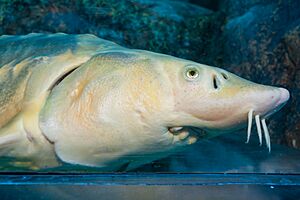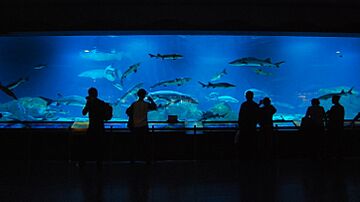Chinese sturgeon facts for kids
Quick facts for kids Chinese sturgeon |
|
|---|---|
 |
|
| Acipenser sinensis | |
| Conservation status | |
| Scientific classification | |
| Synonyms | |
|
The Chinese sturgeon (Acipenser sinensis) is a very special and rare fish. It belongs to a family of fish called Acipenseridae. This amazing fish is currently critically endangered, meaning it's at a very high risk of disappearing forever.
Historically, you could find Chinese sturgeon in the waters around China, Japan, and the Korean Peninsula. Sadly, it has now disappeared from most of these places. This happened because of things like habitat loss (their homes being destroyed) and too much overfishing.
The Chinese government protects this fish very strictly. They call it a "national treasure," much like the famous giant panda. China has many programs to help save the Chinese sturgeon. These include special nature reserves and releasing young sturgeon into the Yangtze River to help their numbers grow.
Contents
About the Chinese Sturgeon
Sturgeon are very old types of fish. Their earliest fossils show they lived during the time of the dinosaurs, in the Cretaceous period. They are known for having skeletons mostly made of cartilage, which is a bendy material like what's in your nose or ears. This is similar to sharks, even though sturgeon are bony fish.
Adult Chinese sturgeon can grow to be very large. They can be between 2 and 5 meters (about 6.5 to 16 feet) long. They can also weigh between 200 and 500 kilograms (about 440 to 1,100 pounds)! This makes them some of the biggest sturgeon in the world. They have a pointed head and a mouth located underneath their jaw.
Life Journey of the Sturgeon

Most sturgeon are what we call anadromous. This means they are born in fresh water, like rivers, but then they travel to salt water, like the ocean, to grow up. The Chinese sturgeon is a large freshwater fish, but it also spends part of its life in the sea, just like salmon. However, unlike salmon, Chinese sturgeon can spawn (lay eggs) many times throughout their lives.
The Chinese sturgeon travels a very long way. They live along the coasts of eastern China. When they are ready to have babies, they migrate back up rivers to lay their eggs. The Chinese sturgeon has the longest migration of any sturgeon in the world. It used to travel more than 3,200 kilometers (about 2,000 miles) up the Yangtze River!
A female sturgeon can lay over a million eggs in one go. These eggs are released and fertilized outside her body. Sadly, less than 1% of the baby sturgeon survive.
When female Chinese sturgeon migrate to the spawning grounds, they stay there for about a year to get ready to lay eggs. Changes in the water temperature of the Yangtze River can delay their spawning time. This can even cause problems with their eggs.
Where They Live
The Chinese sturgeon is native to China. It mostly lives in the main parts of the Yangtze River. You can also find them in coastal areas near the Qiantang River, Minjiang River, and Pearl River. Adult sturgeon are predators. They eat any aquatic animal they can swallow. Young sturgeon eat smaller things like aquatic insects, larvae, and tiny plants called diatoms.
In the 1970s, about 2,000 Chinese sturgeon would spawn in the Yangtze River each year. Now, that number is only a few hundred. This big drop is due to threats to their home, like pollution and other human activities. For example, the Gezhouba Dam was built in the early 1980s. This dam blocked the path for adult fish trying to reach their traditional spawning sites, like the Jinsha River.
Scientists have been watching Chinese sturgeon spawning since the 1980s. From 2013 to 2014, they didn't see any new spawning activity. This made them worry the sturgeon were almost extinct. But in 2015, young sturgeon were found! This showed that the Chinese sturgeon had found a new place to spawn in the Yangtze River after not spawning for a season.
The sturgeon are also very sensitive to noise from boats on the river. They can also get hurt or killed by boat propellers.
Protecting the Chinese Sturgeon
Because the Chinese sturgeon is such an ancient fish, it's very important for scientists to study it. China has been working on ways to breed and protect this endangered species since the 1970s. It is classified as one of "China's Class One Protected Animals."
The Chinese Sturgeon Museum was built in 1982. It's part of an institution that uses special breeding techniques to try and save this endangered fish. The museum is located on a small island called Xiaoxita in the Huangbo River, near Yichang.
Helping Them Grow
The Yangtze River Fisheries Research Institute in Jingzhou is one place that breeds sturgeon in captivity. Their goal is to release these fish into the river to help the wild population grow before the species disappears.
They have had some success with artificial breeding. On April 29, 2005, over 10,000 sturgeon fry (baby fish), 200 junior sturgeon, and two adult fish were released into the Yangtze River at Yichang. So far, about 5 million fish bred in captivity have been released into the wild. However, in 2007, only 14 young sturgeon were found near the mouth of the Yangtze. The year before, 600 were found. This shows that saving the sturgeon in the busy and polluted Yangtze River is still a big challenge.
See also
- List of endangered and protected species of China
- Panda diplomacy



